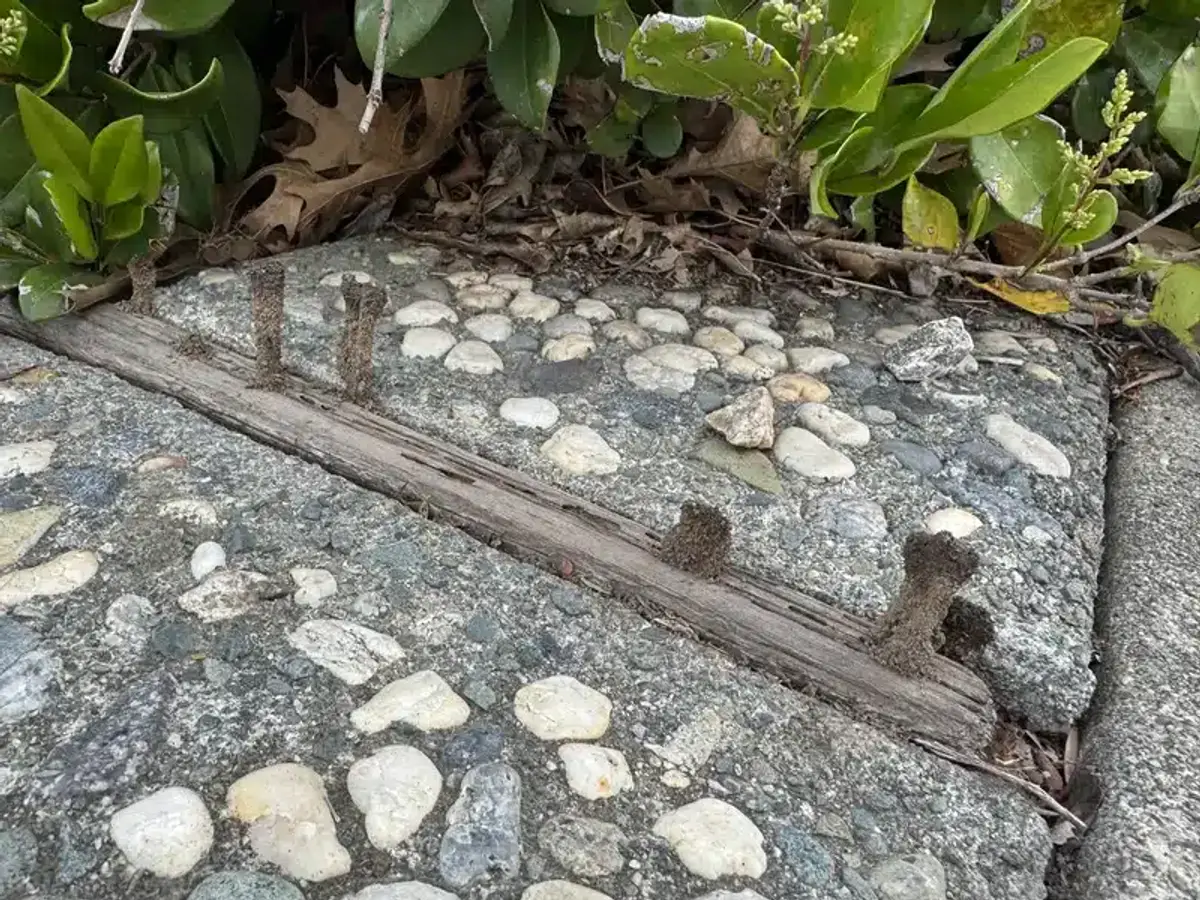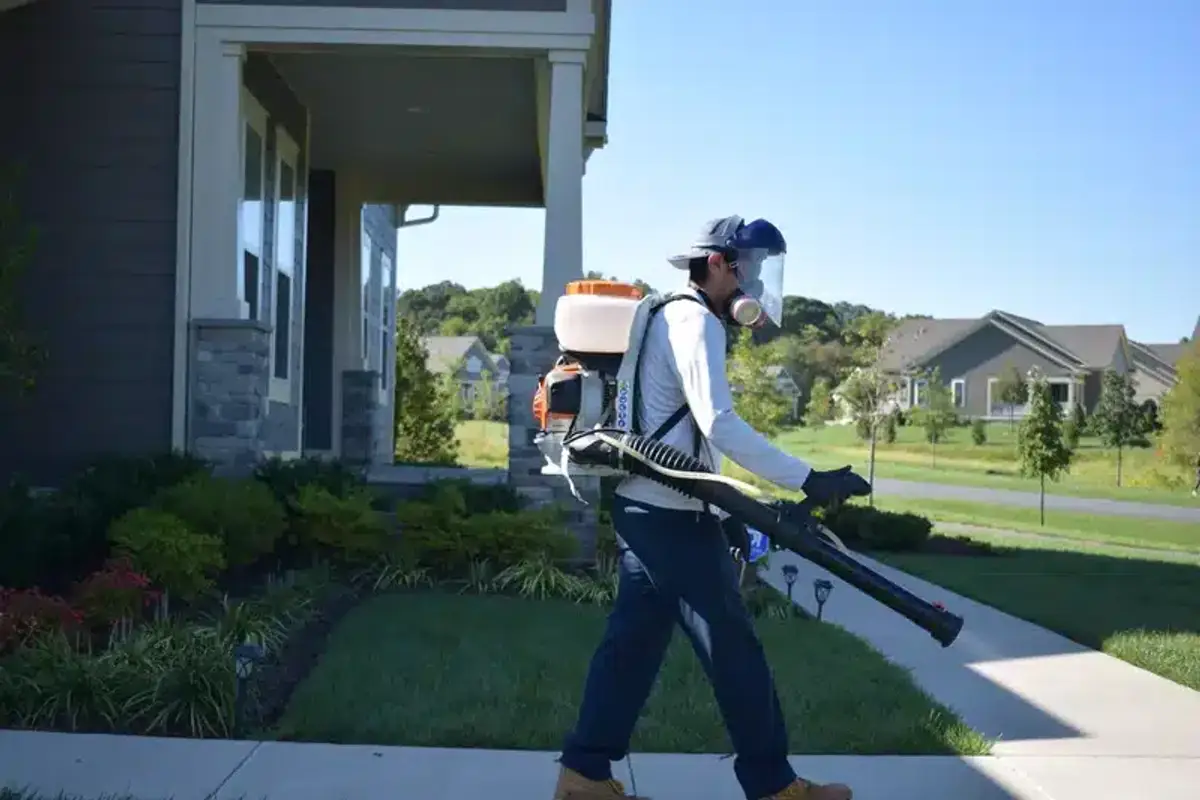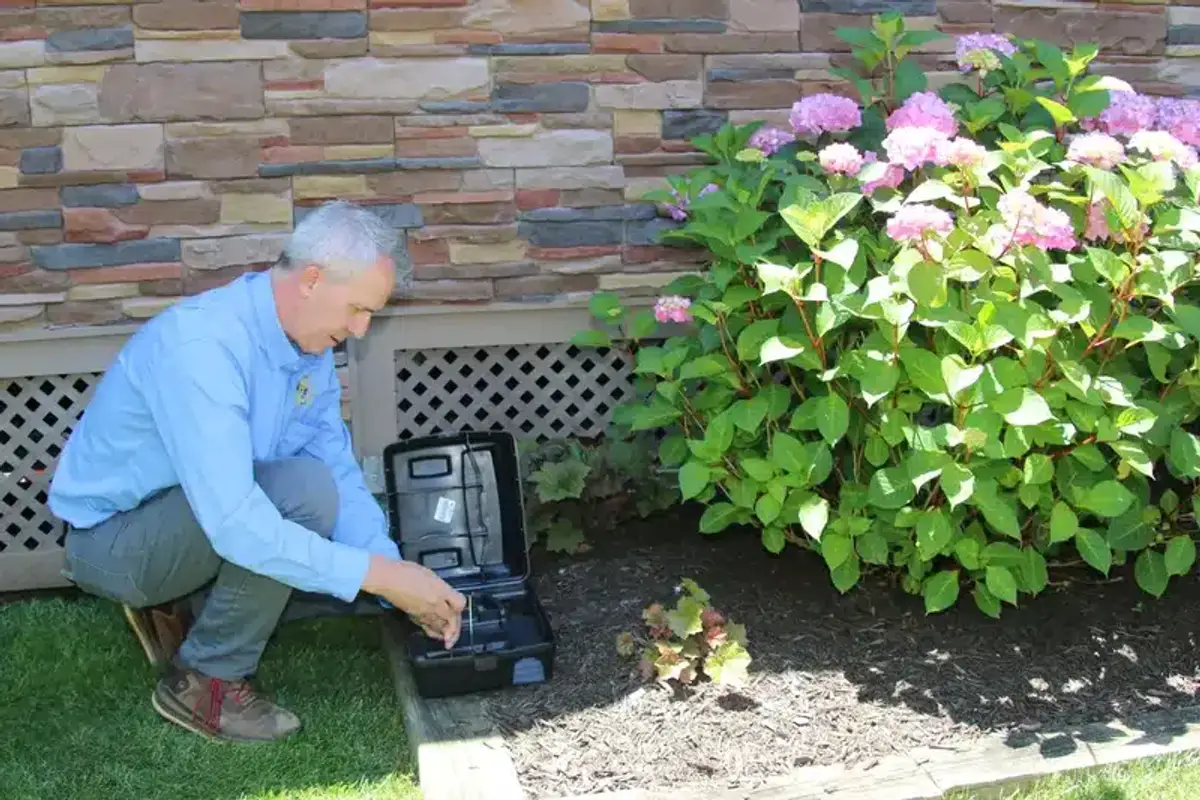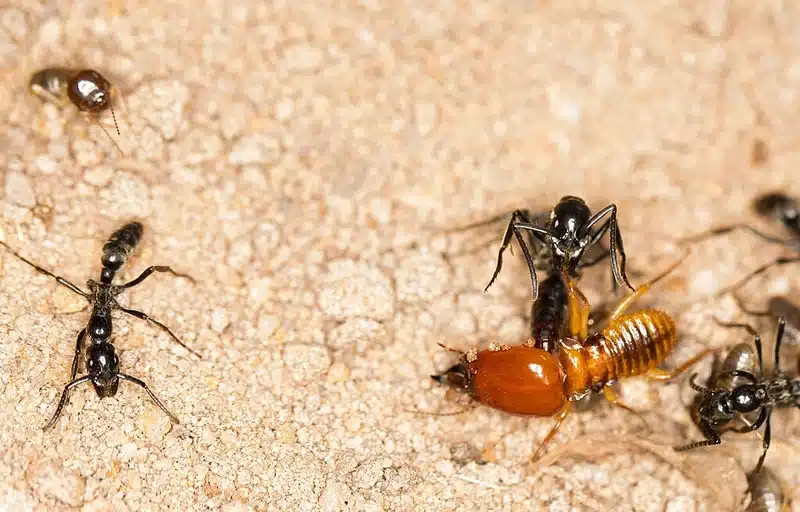When you see small insects crawling around your home or flying in swarms, your first instinct might be panic. Are these termites eating your house, or just ants looking for food? The difference between termites vs ants matters more than you might think—especially when it comes to protecting your Virginia home.
The importance of early detection became clear to me during a training experience that perfectly illustrates how subtle these warning signs can be—and how much damage can occur before homeowners realize they have a problem.
Quick Visual Identification: Termites vs Ants
The fastest way to tell termites vs ants apart is by looking at three key features. These differences become obvious once you know what to look for.
Body Shape and Waist
Termites have a broad, straight body with no visible waist. Their body segments flow together smoothly from head to tail. Ants, on the other hand, have a pinched “wasp waist” that creates a clear separation between their thorax and abdomen.
Antennae Structure
Termite antennae are straight and beaded, like tiny strings of pearls. Ant antennae are elbowed or bent, creating an L-shape that’s easy to spot when you look closely.
Wing Characteristics
When you see flying insects, the wings tell the whole story. Termite swarmers have four wings of equal length that are translucent and much longer than their body. Ant swarmers have two pairs of wings where the front wings are noticeably longer than the back wings.
| Characteristic | Termites | Ants |
|---|---|---|
| Body Shape | Broad, straight body with no visible waist | Pinched “wasp waist” between thorax and abdomen |
| Antennae | Straight and beaded (like pearls) | Elbowed or bent (L-shaped) |
| Wings (when present) | Four equal-length wings, longer than body | Front wings longer than back wings |
| Threat Level | High - structural damage | Low - mostly nuisance pests |
Case Study: When a Small Bulge Revealed Major Damage
During my training in Alexandria, we responded to what seemed like a minor concern—homeowners noticed a small bulge in their window sill. What we discovered changed everything I thought I knew about termite activity and how much damage can accumulate before becoming visible.
- Initial sign: A barely visible bulge in the window sill
- What we found: Termites had eaten right up to the paint layer
- Further investigation: Extensive mud tunnels throughout the crawl space
- Extent of damage: Years of hidden structural damage not visible from outside
- Location: Just a quarter mile from our owner’s home
This experience taught me why understanding the difference between termites vs ants is so critical—and why professional inspections can save homeowners thousands in repair costs.

Understanding Termite Behavior and Damage
After helping over 100 customers with termite issues, I’ve seen how these destructive pests operate. Eastern subterranean termites are the primary concern in Virginia, Maryland, and DC.
How Termites Access Your Home
Termites live underground and build mud tubes to reach wood sources above ground. They can’t tolerate light or dry conditions, so they create these earthen tunnels along foundation walls, pipes, and concrete surfaces. These tubes are about the width of a pencil and are often the first sign homeowners notice.
Termites need constant moisture and soil contact to survive. They typically target areas where wood meets the ground or where moisture problems exist. Crawl spaces, basements, and areas with poor drainage become prime feeding grounds.
Signs of Termite Damage
Termite damage often goes unnoticed for years because they eat wood from the inside out. I’ve seen cases where termites consumed everything up to the paint layer before homeowners discovered the problem. Common warning signs include:
- Hollow-sounding wood when tapped
- Mud tubes on foundation walls
- Small piles of wings near windows and doors
- Blistered or bubbling paint
- Sagging floors or loose door frames

Ant Behavior and Common Species
Spring brings our most common pest complaint: ants. Most homeowners first spot them in kitchens and bathrooms where food and water are accessible. Unlike termites vs ants situations, ant problems are usually more of a nuisance than a structural threat.
Common Virginia Ant Species
Several ant species commonly invade homes in our region. Carpenter ants excavate moist or damaged wood for nesting but don’t actually eat it. Odorous house ants emit a rotten coconut smell when crushed and form large colonies with multiple queens.
Pavement ants nest under concrete slabs and in masonry cracks, while pharaoh ants prefer heated indoor spaces. Each species requires different treatment approaches because their nesting habits and food preferences vary significantly.
Ant Damage vs Termite Damage
The difference between termites vs ants becomes crucial when assessing home damage. Carpenter ants create smooth galleries in wood and leave behind sawdust-like debris called frass. This damage is typically localized to areas with moisture problems.
Most other ant species cause no structural damage. They’re primarily nuisance pests that contaminate food and create unsanitary conditions. The urgency and cost of treatment differ dramatically from termite infestations.


Professional Termite and Ant Treatment Methods
The treatment approach for termites vs ants differs significantly based on the pest type and severity of infestation. Understanding these differences helps homeowners make informed decisions about professional services.
Termite Treatment Options
My experience shows that proactive termite treatment typically costs less and causes less stress than dealing with established infestations. The Sentricon system works well for prevention and early-stage problems because of its high success rate.
For severe infestations where termites can’t find bait stations, we use targeted liquid treatments with products like Premise or Termidor. These create a chemical barrier around your home’s foundation. The treatment involves trenching around the structure and sometimes drilling concrete slabs or front stoops.
Annual termite inspections help catch problems early. During these visits, our registered technicians probe the soil around your foundation, check for mud tubes, and test wood for hollow sounds that indicate damage.

Ant Treatment Strategies
Ant treatment focuses on two main approaches: baiting and targeted applications. Our technicians start by inspecting interior areas where ant activity occurs, particularly kitchens, bathrooms, and basements. We look for trails, entry points, and nesting areas.
The initial treatment involves crack and crevice applications using non-repellent insecticides. Since ants are social creatures, non-repellent products work better because ants unknowingly spread the material throughout their colony rather than avoiding treated areas.
Exterior perimeter treatments create a barrier around your home’s foundation. Most ant control programs require quarterly maintenance visits because treatment materials typically last about 90 days.
Termite and Ant Prevention for Long-term Protection
Preventing termites vs ants requires different strategies because these pests have different needs and behaviors. Moisture management benefits both prevention efforts, but specific tactics vary.
Termite Prevention Essentials
Effective termite prevention starts with eliminating moisture problems. Keep gutters clean, fix leaky pipes, and maintain proper drainage around your foundation. Remove wood-to-soil contact by storing firewood away from your home and removing old stumps.
What does the science say?
The EPA’s termite prevention guidelines emphasize that moisture control is the most effective first line of defense against termite infestations. Their research shows that subterranean termites require constant moisture contact and are attracted to areas with humidity levels above 60%. By eliminating moisture sources and maintaining proper drainage, homeowners can significantly reduce the risk of termite establishment, often preventing infestations before they begin.
Create physical barriers where possible. Maintain at least six inches of clearance between soil and wood siding. Consider professional-grade moisture control in crawl spaces and basements where termites typically gain access.
Essential Termite Prevention Steps
- Moisture Control: Fix leaks promptly, maintain 6-inch clearance between soil and siding, and keep crawl space humidity below 60%
- Remove Wood Contact: Store firewood away from your home and remove dead tree stumps from your property
- Professional Inspections: Schedule annual termite inspections to catch problems before they become expensive
- Drainage Maintenance: Keep gutters clean and ensure proper grading around your foundation
Ant Prevention Techniques
Ant prevention focuses on eliminating food sources and entry points. Store food in airtight containers and clean up crumbs immediately. Fix moisture problems in bathrooms and kitchens where ants commonly appear.
Seal cracks around windows, doors, and where utilities enter your home. Trim vegetation away from your house to eliminate ant highways. Regular cleaning disrupts scent trails that guide other ants to food sources.

When to Call Professional Help
Timing matters when dealing with termites vs ants. Termite situations always require immediate professional attention because structural damage accumulates over time. Research shows that a mature termite colony can consume about one foot of a 2x4 board per year.
What does the science say?
According to USDA Forest Service research, subterranean termites can cause significant structural damage in a surprisingly short time. Their studies document that a mature colony of 100,000+ termites can consume approximately one linear foot of a 2x4 board annually. This research helps pest control professionals understand the urgency of treatment and why annual inspections are critical for early detection and prevention of costly structural repairs.
Ant problems often start as DIY projects, but certain situations demand professional intervention. Carpenter ants nesting inside your home’s structure, large infestations that return after treatment, or multiple ant species require expert identification and targeted treatment approaches.
Our 78-point inspection process identifies both active problems and conditions that attract pests. We check everything from entry points to moisture issues, creating a comprehensive treatment plan based on your specific situation.
When to Call Immediately
If you find mud tubes, see swarmers, or notice hollow-sounding wood, don’t wait. Termite damage accumulates daily, and early intervention can save thousands in structural repairs.
The Better Termite & Pest Control Approach
For over 57 years, our family-owned company has served Virginia, Maryland, and DC homeowners with effective termite and ant control. We’ve eliminated 9 of the industry’s harshest chemicals from our treatment programs, choosing products like Essentria, Alpine, Sentricon, and Borate-based solutions.
Our registered technicians take your calls directly—no phone trees or overseas operators. You’ll receive a detailed quote and treatment plan based on your specific situation. We offer free unlimited callbacks because we’ll keep coming back until your pest problem is solved.
Whether you’re dealing with termites or ants, early intervention saves money and prevents damage. Our seasonal protection plans run smoothly in the background, targeting specific pests during their most active periods.
Termite and Ant Seasonal Timing and Swarming Patterns
Understanding when termites vs ants are most active helps homeowners stay alert for potential problems. Termite swarms in Virginia typically occur from March through May during warm, humid days following rain.
Ant reproductive flights usually happen later, from May through August. However, carpenter ants may swarm indoors during late winter if their nest gets warmed. These timing differences help with identification and treatment planning.
Both pests remain active year-round in heated homes, but their outdoor activity patterns change with seasons. Monitoring during peak activity periods increases your chances of early detection.
Understanding the differences between termites vs ants helps you respond appropriately to pest problems in your home. While both require attention, termites demand immediate professional intervention due to their destructive potential. Most ant issues can be managed with proper prevention and occasional professional treatment.
Don’t wait until small warning signs become major problems. If you’re unsure whether you’re dealing with termites or ants, call Better Termite & Pest Control at 703-683-2000 for a professional inspection. You can also email us at info@bettertermite.com with any questions about protecting your Virginia home from destructive pests.
Frequently Asked Questions
How can I quickly tell the difference between termites vs ants?
+
Look at three key features: termites have straight antennae and broad waists with no pinching, while ants have elbowed antennae and pinched "wasp waists." Flying termites have four equal-length wings, while flying ants have longer front wings.
Are termites or ants more dangerous to my home?
+
Termites pose a much greater structural threat than most ants. Termites eat wood and can cause thousands of dollars in damage over time. Most ants are nuisance pests, though carpenter ants can damage moist or rotted wood areas.
When do termites vs ants typically swarm in Virginia?
+
Termite swarms usually occur from March through May on warm, humid days. Ant swarms typically happen later, from May through August. However, carpenter ants may swarm indoors during late winter if their nest gets heated.
Can I treat termites myself, or do I need professional help?
+
Termite treatment requires professional intervention due to the specialized equipment and EPA-regulated products needed. Most soil treatments are restricted to licensed applicators. DIY attempts often fail because termites are hidden and require comprehensive barrier treatments.
What attracts termites vs ants to homes differently?
+
Termites are attracted to cellulose in wood and need constant moisture and soil contact. Ants are attracted to food sources, water, and shelter opportunities. Both prefer areas with moisture problems, but termites specifically need wood while ants seek varied food sources.
How much damage can termites vs ants cause annually?
+
A mature termite colony can consume about one foot of a 2x4 board per year, potentially causing thousands in structural damage. Most ants cause minimal damage, except carpenter ants which can hollow out moisture-damaged wood areas but don't actually eat the wood.
What are the early warning signs of termites vs ants?
+
Early termite signs include mud tubes on foundations, hollow-sounding wood, and discarded wings near windows. Early ant signs include visible trails, small piles of sawdust-like material (from carpenter ants), or actual ants in kitchens and bathrooms seeking food and water.
Do termites and ants ever conflict with each other?
+
Yes, ants are natural predators of termites and will attack termite colonies when they encounter them. However, both pests can exist in the same area since they have different food sources and nesting requirements. Finding ants doesn't mean you're protected from termites.
With five years of hands-on experience in the pest control industry, George Schulz is a registered technician with the Virginia Pest Management Association and a proud third-generation professional in a family business that's been protecting homes for over 57 years. He manages and trains a team of service pros while also leading internal research efforts—recently spearheading a deep-dive review of thousands of documents on pest control materials to hand-pick the most kid and pet friendly, most effective solutions tailored specifically for homes in the DC metro area.
